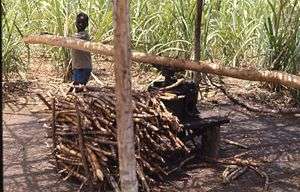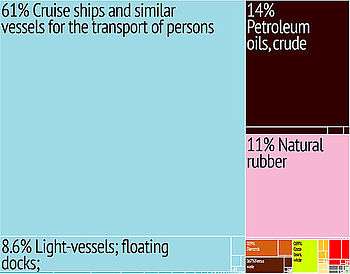Economy of Liberia
Trade organizations | AU, African Development Bank, ECOWAS, MRU, WAMZ, World Bank, IMF, WTO, Group of 77 |
|---|---|
| Statistics | |
| GDP |
Rank: 185 (2012 est.) |
GDP growth |
|
GDP per capita |
$700 (PPP) (2012 est.) Rank: 224 (2012 est.) |
GDP by sector |
agriculture 62.7% industry 6.4% services 30.8% (2010 est.) |
|
| |
Population below poverty line | 80% (2000 est.) |
Labor force | 1.372 million (2007 est.) |
Labor force by occupation |
agriculture 70% industry 8% services 22% (2000 est.) |
| Unemployment | 3.7% (2010 est.)[1] |
Main industries | rubber processing, palm oil processing, timber, diamonds |
| 151st[2] | |
| External | |
| Exports |
|
Export goods | iron, diamonds, timber, rubber, cocoa, coffee |
Main export partners |
|
| Imports |
|
Import goods | machinery, transportation equipment, fuel, chemicals, manufactured goods, food, Foreign Aid |
Main import partners |
|
Gross external debt |
|
| Public finances | |
| Revenues | $481.5 million (2012 est.) |
| Expenses | $522.3 million (2012 est.) |
| Economic aid | recipient: International multi-billion dollar debt relief and development aid |
Liberia is one of the poorest countries in the world, and its economy is extremely underdeveloped, largely due to the First Liberian Civil War in 1989-96. The civil war destroyed much of Liberia's economy, especially the infrastructure in and around Monrovia. The war also caused a brain drain and the loss of capital, as the civil war involved overthrowing the Americo-Liberian minority that ruled the country. Some returned during 1997, but many have not.
Richly endowed with water, mineral resources, forests, and a climate favorable to agriculture, but poor in human capital, infrastructure, and stability, Liberia has a fairly typical profile for Sub-Saharan African economies – the majority of the population is reliant on subsistence agriculture, while exports are dominated by raw commodities such as rubber and iron ore. Local manufacturing, such as it exists, is mainly foreign-owned.
The democratically elected government, installed in August 1997, inherited massive international debts and currently relies on revenues from its maritime registry to provide the bulk of its foreign exchange earnings. The restoration of the infrastructure and the raising of incomes in this ravaged economy depend on the implementation of sound macro- and micro-economic policies of the new government, including the encouragement of foreign investment.
Economic history
The Liberian economy had relied heavily on the mining of iron ore prior to the civil war. Liberia was a major exporter of iron ore on the world market. In the 1970s and 1980s, iron mining accounted for more than half of Liberia's export earnings. Since the coup d'état of 1980, the country's economic growth rate has slowed down because of a decline in the demand for iron ore on the world market and political upheavals in Liberia.
The United Nations imposed sanctions on Liberia in May 2001 for its support to the rebels of the Revolutionary United Front (RUF) in neighboring Sierra Leone. These sanctions have been lifted following elections in 2005.
In March 2010, Bob Johnson, founder of BET, funded the first hotel constructed in Liberia in 20 years. The 13-acre (53,000 m2) luxury resort was built in the Paynesville section of Monrovia.[5]
Liberia's external debt was estimated in 2006 at approximately $4.5 billion, 800% of GDP.[6] As a result of bilateral, multilateral and commercial debt relief from 2007 to 2010, the country's external debt fell to $222.9 million by 2011.[7]
Economic sectors

Liberia's business sector is largely controlled by foreigners mainly of Lebanese and Indian descent. There also are limited numbers of Chinese engaged in agriculture. The largest timber concession, Oriental Timber Corporation (OTC), is Indonesian owned. There also are significant numbers of West Africans engaged in cross-border trade. Legal monopolies are possible; for example, Cemenco holds a monopoly on cement production.
Unlike almost all other countries in the world, Liberia has not adopted the metric system as its primary system of measurement.
Forestry
Timber and rubber are Liberia's main export items since the end of the war. Liberia earns more than $100 million and more than $70 million annually from timber and rubber exports, respectively.
Mining and resources
Alluvial diamond and gold mining activities also account for some economic activity. In recent years (2005 - 2012), foreign investment from ArcelorMittal Steel, BHP Biliton, and China Union is aiding the revitalization of the iron-ore mining sector.
Liberia has begun exploration for offshore oil; unproven oil reserves may be in excess of one billion barrels.[8] The government divided its offshore waters into 17 blocks and began auctioning off exploration licenses for the blocks in 2004, with further auctions in 2007 and 2009.[9][10][11] An additional 13 ultra-deep offshore blocks were demarcated in 2011 and planned for auction.[12] Among the companies to have won licenses are Repsol, Chevron, Anadarko and Woodside Petroleum.[13]
Shipping flag of convenience
Liberia maintains an open maritime registry, meaning that owners of ships can register their vessels as Liberian with relatively few restrictions. This has meant that Liberian ship registration is usually understood as the employment of a flag of convenience. Liberia has the second-largest maritime registry in the world behind Panama, with 3,500 vessels registered under its flag accounting for 11% of ships worldwide.[14][15] This includes 35% of the world's tanker fleet. Liberia earned more than $18 million from its maritime program in 2000.
Foreign aid
Liberia has relied heavily on vast amounts of foreign assistance, particularly from the United States, Japan, Britain, France, Italy, Germany, the People's Republic of China, and Romania. But because of the Liberian Government's perceived disregard for human rights, foreign assistance to Liberia has declined drastically.
The Republic of China (Taiwan) and Libya are currently the largest donors of direct financial aid to the Liberian Government. Significant amounts of aid continue to come in from Western countries through international aid agencies and non-governmental organizations, avoiding direct aid to the government.
Communications
Communications in Liberia refers to the press, radio, television, fixed and mobile telephones, and the Internet. There are six major newspapers in Liberia, and 45% of the population has a mobile phone service. Also, the radio stations in Liberia are abundant to the extend that there are over 70 radio stations in the entire country (Liberia). As for Montserrado County, there exist about 30 radio stations.
Even as it struggles with economic and political constraints, Liberia’s media environment is expanding. The number of registered newspapers and radio stations (many of them community stations) is on the rise despite limited market potential. And politically critical content and investigative pieces do get published or broadcast.[16]
Energy
Formal electricity services are solely provided by the state-owned Liberia Electricity Corporation, which operates a small grid almost exclusively in the Greater Monrovia District.[17] The vast majority of electric energy services is provided by small privately owned generators. At $0.54 per kWh, the electricity tariff in Liberia is among the highest in the world. Total installed capacity in 2013 was 20 MW, a sharp decline from a peak of 191 MW in 1989.[17]
International economic networks

Liberia is a member of the Economic Community of West African States (ECOWAS). With Guinea and Sierra Leone, it formed the Mano River Union (MRU) for development and the promotion of regional economic integration. The MRU became all but defunct because of the Liberian civil war which spilled over into neighboring Sierra Leone and Guinea.
See also
References
- ↑ "Report on the Liberia Labour Force Survey 2010" (PDF). Liberia Institute of Statistics and Geo-Information Services (LISGIS). February 2011.
- ↑ "Doing Business in Liberia 2012". World Bank. Retrieved 2011-11-21.
- ↑ "Export Partners of Liberia". CIA World Factbook. 2012. Retrieved 2013-07-27.
- ↑ "Import Partners of Liberia". CIA World Factbook. 2012. Retrieved 2013-07-27.
- ↑ "Fact Sheet - RLJ Kendeja Resort & Villas".
- ↑ "The Challenges of Post-War Reconstruction—the Liberian Experience". Government of Liberia. allAfrica.com. June 13, 2011.
- ↑ "Second Quarter 2010/2011 Public Debt Management Report" (PDF). Debt Management Unit. Ministry of Finance. March 25, 2011.
- ↑ "Liberia may have over 1 bln barrels in oil resources". Reuters Africa. November 3, 2009.
- ↑ "NOCAL 2004 Liberia Offshore Bid Round Announcement". Business Wire. February 2, 2004.
- ↑ Pearson, Natalie Obiko (December 10, 2007). "Liberia Opens Bidding for 10 Offshore Oil Blocks". RigZone.
- ↑ "Third Liberian Offshore Petroleum Licensing Round 2009". Deloitte Petroleum Services. Deloitte. August 27, 2009.
- ↑ Toweh, Alphonso (July 21, 2011). "Liberia marks out new oil blocks, auction seen soon". Reuters. Retrieved August 22, 2011.
- ↑ Konneh, Ansu (August 30, 2010). "Chevron, Liberia Sign Deepwater Offshore Exploration Agreement". Bloomberg News.
- 1 2 Schoenurl, John W. (August 11, 2003). "Liberian shipping draws scrutiny". msnbc.com.
- 1 2 "About the Liberian Registry". Liberian Registry.
- ↑ "Media Environment and Regulation in Liberia", AudienceScapes. Retrieved 8 February 2014.
- 1 2 "Options for the Development of Liberia's Energy Sector" (PDF). International Bank for Reconstruction and Development. World Bank Group. 2011.
External links
- 68% of Liberians live in poverty census reveals
- Economy of Liberia at DMOZ
- Mineral resources of Liberia
- Liberia latest trade data on ITC Trade Map
- Liberia profile - World Bank